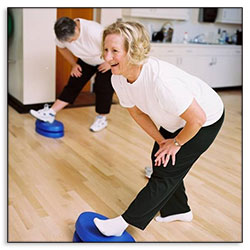Exercise
OHSU Fibromyalgia Exercise DVDs
Directed by Dr. Robert Bennett and Dr. Kim Dupree-Jones, for over 25 years the Oregon Health and Science University Fibromyalgia Research Group has developed better and more tolerable exercise programs for people with fibromyalgia. People with FM demonstrate the exercises.

Exercise and fibromyalgia – ugh! For many people with fibromyalgia these are almost ‘fighting” words. After all if, because of pain and fatigue, it is almost impossible to move from a chair or bed to get food or water, how in the world is a person supposed to exercise! Such is the dilemma of people with fibromyalgia and other chronic pain conditions. And yet, not moving ultimately causes more pain and fatigue and adds to a vicious cycle of deconditioning. There is another word that is difficult to assimilate into a chronic pain patient’s vocabulary; especially if they were active all of their life before illness rendered them unmovable.
Without moving a person’s muscles atrophy and then when they do try to walk to the mailbox, they hurt more the next day. It is natural for a person to take warning signs being sent from their own body as clues to what they should or should not do. For instance if they held their hand in an open flame, they would quickly remove it, because pain is the driving force of this protective response. But in the case of fibromyalgia those warning signs are sometimes not the best choice of action.
Closing down and not moving actually sets people up for a secondary pain problem: normal muscle atrophy that happens when a person is not active for as little as two weeks. Those inactive muscles react the same as a healthy person’s who has not exercised for a period of time; when they finally do move they hurt from muscle micro-trauma caused from microscopic tears in the muscles. The plus side for the healthy person is they will rebound quickly and after a few days of moving they will no longer hurt.
For people with fibromyalgia they get a double “whammy” when they don’t move; it is not all fibromyalgia pain, but a combination of normal exercise induced pain in conjunction with their fibromyalgia symptoms. But if the person with FM perseveres and continues to move, the muscles will become stronger and the normal exercise rebound pain will abate. And as an added advantage they will become stronger and better able to support their bodies by conditioning their sick muscles, making them ultimately feel better with less overall pain.
The Oregon Health and Science University Fibromyalgia Research Center has worked for more than 25 years to develop better and more tolerable exercise programs for people with fibromyalgia. They are the forerunners of pushing for people with fibromyalgia to move. Through the years they have become the most successful research group in creating successful fibromyalgia exercise programs captured on DVDs. The truly wonderful thing about their videos is that all of the people demonstrating the exercises are fibromyalgia patients.
Years ago when one of the exercise demonstrators first came to see Dr. Robert Bennett and his research group she was in a wheel chair; now she is part of the exercise video group. The other wonderful thing about these videos is the professional fibromyalgia specific information shared by medical experts and researchers on each disk to help people live better with this illness. Through the years they have produced and updated four fibromyalgia exercise DVDs which educate fibromyalgia participants about how to correctly perform a variety of different movements including:
• Yoga and Pilates
• Stretching and Relaxation
• Strength and balance
• Aerobic Exercise
• Stretching and Relaxation
• Strength and balance
• Aerobic Exercise
Find more information about each of these four DVD’s and incorporate them in to your fibromyalgia and chronic pain self-management strategies. For more information about the Strength and Balance DVD offered on the Fibromyalgia Information Foundation web site, visit http://www.myalgia.com/VIDEOS/Video_Introduction.htm
It is important to note that this DVD may be bought separately or as a package.
Strength and Balance DVD
1. Test your balance and improving your posture. Dr. Kim Jones instructs you in performing a series of balancing movements which test the major components of successful balancing (inner ear, eyes and muscles). She also demonstrates how to regain optimal postural alignment. Before beginning the exercises in this video, you'll want to be in good postural alignment, whether you are seated or standing. This will help prevent injury and unnecessary muscle fatigue.
2. Balance and Strength exercises. Janice Hoffman, a certified clinical exercise specialist, takes 3 FM patients through a workout is divided into: 3 sections: (1) upper-body strength, (2) core (torso) strength and (3) lower-body strength and balance work. Gentle stretching for the specific muscles used during each workout section is included. Whether you are a beginner or are more advanced, this program will be useful for you. To progress, simply increase the amount of resistance, or decrease the firmness of your balance surface.
3. Balance strategies and adaptive aids. Cinda Hugos, a physiotherapist, discusses various balance aids and the best footwear for good stability, along with strategies for navigating in crowded public locations.
4. Education. Dr. Robert Bennett presents a 20-minute session on the essential features of a comprehensive management program for FM patients, including the rationale for using various medications.
4. Education. Dr. Robert Bennett presents a 20-minute session on the essential features of a comprehensive management program for FM patients, including the rationale for using various medications.





